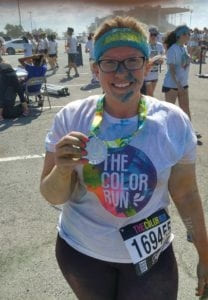Last weekend, I ran my first 5k race! Well, I ran most of it — but that’s not the point.
A month and a half ago I made the spontaneous decision to start training for the Color Run, a non-competitive course dubbed the “Happiest Race On Earth!” Every kilometre or so there is a “colour zone”, where volunteers pelt you with coloured powder until you can hardly see and breath. I figured it would be a fun way to get fit and challenge myself during a time in my life where everything seemed to stand still.
However, I didn’t realize how much of a challenge it would be. When I first started running I could go for about 30 seconds at a time before collapsing into a puddle of sweat and tears. After my first week I thought it would be impossible. I’m what society would consider a larger girl, and therefore I was experiencing a lot of shin splints and pressure on my ankles when I ran. I found the movement itself difficult and exhausting. There was no way that I would be able to run for 30-40 minutes straight!
But, I vowed I would at least try.
I trained using the app “Couch to 5k”, which uses intervals to slowly increase endurance — or in my case simply get my body used to the movement! It was great the first week because it started with one minute of running and then moved up in intervals of 30 seconds. However, by the third week, it seemed as if every two days the app was telling me to run two minutes longer than I had before.
The interval training was working! Soon, I could run five minutes at a time, then eight, then 10! By the time my race day had come around, I could run about 18 minutes straight. I have to say I am immensely proud of my progress and I really don’t care that I couldn’t run the whole 5 kilometres. This was a success in my eyes!
The key to this type of training was to move at my own speed. Sure, the app says I should be running eight-minute intervals, but if I couldn’t do the six-minute interval the day before, then what’s the point of moving on. Nothing is more discouraging than stopping before the darn app tells you to. At that point I would ignore the app and redo that workout until I felt comfortable pushing myself to go to the next level.
It’s also important to keep yourself accountable. I started a (mostly) weekly video diary about my progress and the challenges I was facing. These videos helped me connect with friends who were runners for advice and motivation. It’s especially useful when your progress has stagnated and you need a little bit of extra encouragement.
Race day came up quickly and that morning I couldn’t contain my excitement. The Color Run itself is non-competitive, so it was the perfect race to start with. No one was timing me and most of the participants walked anyway. I went with a friend (who coincidentally runs at the same speed as I do, which was perfect) and had an absolute blast. I’m proud to say that we ran most of the way, only stopping to walk through the colour zones because there was so much traffic and we wanted to make sure we got lots of splashes of powder. It also provided me with the perfect excuse to catch my breath. The only problem was that the powder would get in our eyes and mouth. I now understand why some people sported goggles and bandanas.

But, that’s it! The race is over and I’m left wondering: what now?
I’ve decided to keep running. I still want to be able to run a full 5k, and I think that after two more months of training it may be possible. My next race will be sometime in September or early October.
Wish me luck!
If you are thinking of getting into the race-game, here are five things I learned about running:
Get good shoes: I had to switch my shoes out half way through my training because they weren’t supportive enough. If you are going to start running, make sure you invest in top-notch athletic shoes.
Run outside: If you have a gym membership, it may seem easier to do your running training on a treadmill. But running indoors is very different to the rough and unpredictable terrain you will be faced with on race day. It’s important to get your body used to the feel of pavement and grass under your feet, not to mention the curves of the road.
Stretching is important: I soon learned that I needed a good 10 minutes of stretches before I ran to avoid shin splints and sore muscles. Do more than just stretch our your calf muscles. Everything in your body is connected, so stretching your hips, your back, your neck, and your arms can be just as important as your legs. Don’t run the day before your race — instead, just do some relaxing yoga and make sure your body is nice and rested.
Don’t run with people who are more fit than you: This is a personal preference. Others may enjoy the extra pressure and push they may get from running with a really fit friend, but if you are overweight and just starting out, focus on your own journey. It’s already hard enough to watch an old man run four laps to your one. Who needs a friend to do it too?
It’s hard: It’s not like getting together with friends to play a sport — running is very solitary and if you don’t have some good music to listen to, it’s really easy to get stuck in your head. It’s also easy to stop even if your body can be pushed a little further. Running is all about you and for some people (myself included) that can be quite an adjustment.
Have you run a race this summer? If so, let us know your tips and tricks in the comments below!


